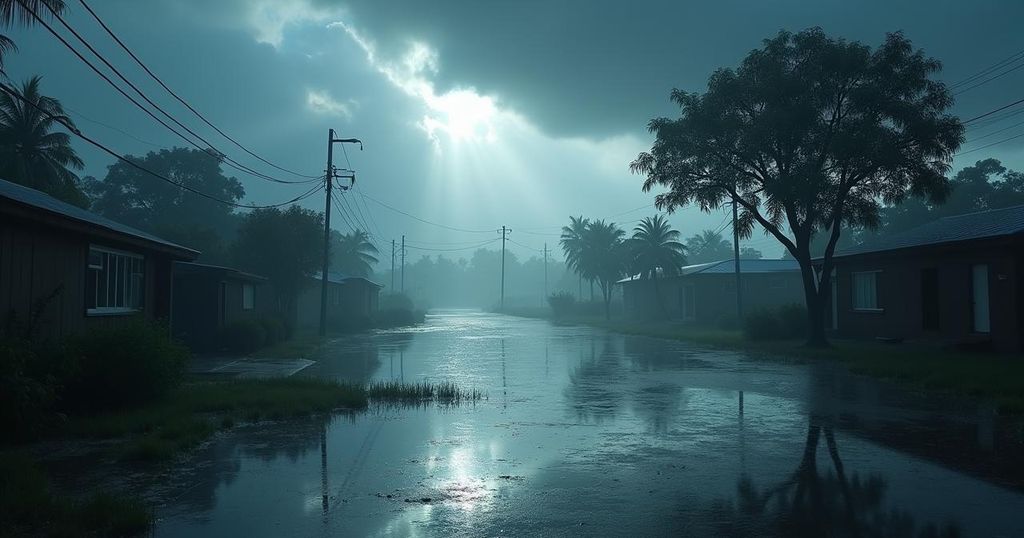Unprecedented Rainfall: Hurricane Helene and Its Catastrophic Impact on the Southeast United States

Over 40 trillion gallons of rain inundated the Southeast US due to Hurricane Helene and another storm, resulting in catastrophic flooding and over 100 deaths. Experts emphasize the unprecedented scale of the rainfall and examine the influence of climate change on such extreme weather events.
In the previous week, more than 40 trillion gallons of rain inundated the Southeastern United States, a phenomenon attributed to Hurricane Helene and a preceding rainstorm, which has astonished meteorological experts. This staggering volume of water is equivalent to filling the Dallas Cowboys’ stadium 51,000 times or Lake Tahoe once. In North Carolina alone, the rainfall would be approximately 3.5 feet deep, and the equivalent of over 60 million Olympic-sized swimming pools. Ed Clark, the director of the National Oceanic and Atmospheric Administration’s (NOAA) National Water Center, noted the unprecedented scale of the event: “That’s an astronomical amount of precipitation. I have not seen something in my 25 years of working at the weather service that is this geographically large of an extent and the sheer volume of water that fell from the sky.” The aftermath of the flooding has resulted in catastrophic damage, with official reports indicating over 100 fatalities. Meteorologist Ryan Maue, who utilized satellite and ground observation measurements, calculated that 40 trillion gallons of rain fell over the eastern United States, with 20 trillion gallons attributed to Hurricane Helene alone, severely impacting Georgia, Tennessee, the Carolinas, and Florida. Clark corroborated this figure, underscoring its significance: “the 40 trillion gallon figure (151 trillion liters) is about right and, if anything, conservative.” He further emphasized that this amount exceeds twice the combined resources of the key reservoirs in the Colorado River basin, Lake Powell and Lake Mead. The meteorological phenomenon resulted from the convergence of multiple storm systems, with a low-pressure system stalling over the Southeast and a late tropical storm contributing to the intense rainfall. North Carolina’s climatologist, Kathie Dello, stated that some areas received as much as 20 inches of rain. Furthermore, Helene, one of the largest storms in recent years, intensified the rainfall due to its rapid movement and capacity for moisture retention. Kristen Corbosiero, a hurricane expert, highlighted that the mountains exacerbated the situation by capturing more moisture present in the air, resulting in overwhelming runoff in higher elevations. In North Carolina, the highest recorded rainfall was 31.33 inches in Busick, with Mount Mitchell receiving over 2 feet. Clark expressed concern regarding the contemporary measurement of rainfall. He mentioned, “Before 2017’s Hurricane Harvey, I said to our colleagues, you know, I never thought in my career that we would measure rainfall in feet.” Such events, which were once considered anomalies, are becoming increasingly common as climate change drives wetter and more severe storms. Corbosiero and Dello noted that a law of physics dictates that warmer air contains nearly 4% more moisture for each degree Fahrenheit increase in temperature. As the global climate has warmed by over 2 degrees since pre-industrial times, the connection to increased rainfall is becoming clearer. A preliminary analysis by scientists at Lawrence Berkeley National Lab concluded that climate change was responsible for 50% more rainfall during Helene in certain areas of Georgia and the Carolinas. Dello asserted that the evidence of climate change is unmistakable, stating, “We’ve seen tropical storm impacts in western North Carolina. But these storms are wetter and these storms are warmer. And there would have been a time when a tropical storm would have been heading toward North Carolina and would have caused some rain and some damage, but not apocalyptic destruction.”
This article discusses a recent extraordinary weather event in the Southeastern United States, which was marked by an unprecedented amount of rainfall due to Hurricane Helene and a preceding rainstorm. The phenomenon has raised concerns among meteorologists regarding the implications of climate change on storm intensity and precipitation levels. With fatalities and severe flooding reported, experts are analyzing the environmental and climatic factors that led to such an extraordinary deluge.
The torrential rains resulting from Hurricane Helene and accompanying storms have caused catastrophic flooding across the Southeastern United States, with fatalities exceeding 100 and vast quantities of rainfall recorded. Meteorologists acknowledge this event as significant and unprecedented, emphasizing the potential role of climate change in intensifying such storms. As researchers continue to investigate the impact of rising global temperatures on weather patterns, it is evident that the frequency and severity of such rainfall events may increase.
Original Source: www.pbs.org






